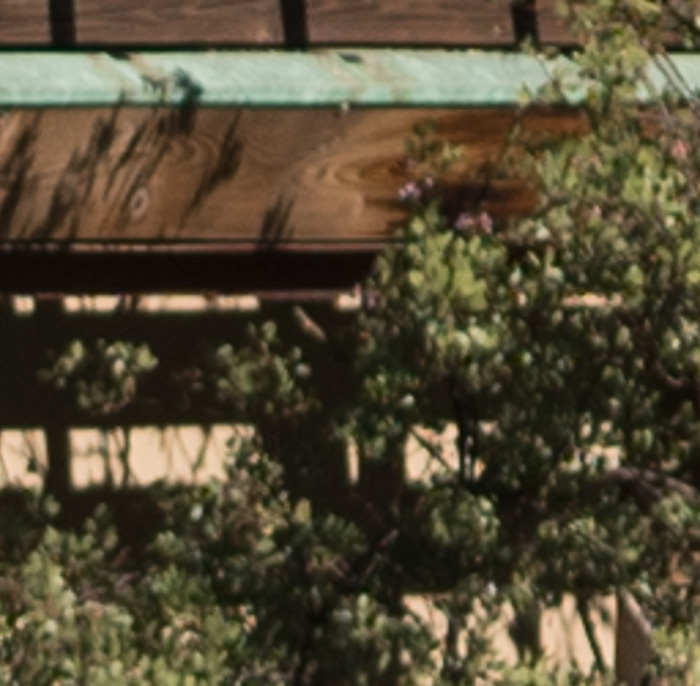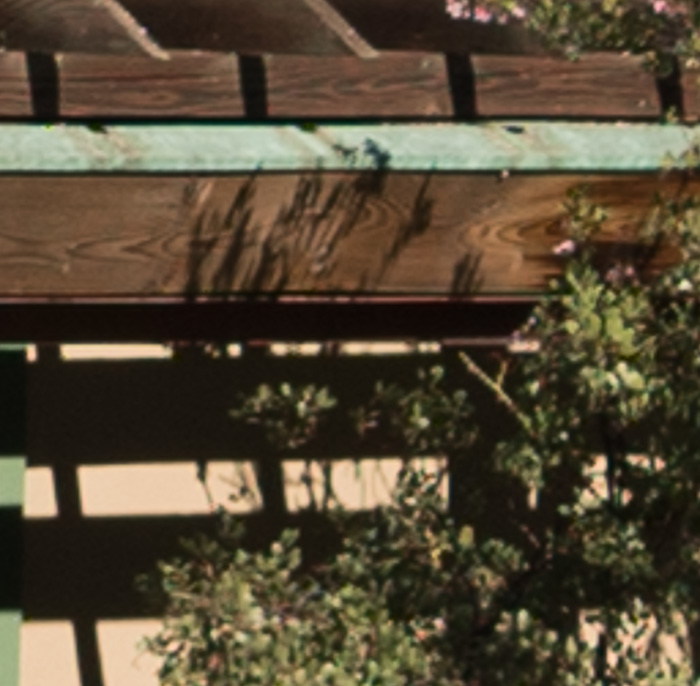This is a continuation of a test of the following lenses on the Sony a7RII:
- Zeiss 85mm f/1.8 Batis.
- Zeiss 85mm f/1.4 Otus.
- Leica 90mm f/2 Apo Summicron-M ASPH.
- AF-S Nikkor 85mm f/1.4 G.
- Sony 90mm f/2.8 FE Macro.
The test starts here.
We’ll look can look at 300% center and corner crops images from all five lenses.
In the center:





The differences are subtle, The Sony looks to be slightly softer than the rest, and the Otus sharper and more contrasty, but these are all nice images.
In the corner:





All pretty nice. The ‘lux and the Sony are the softest. The Otus has an etched contrast that some — but not I — might say is too much. Is that where the disparaging word “clinical” comes from?
I always wonder about “clinical” rendering…
I have a Ricoh GR which has an incredibly sharp and contrasty lens that’s definitely what one might call clinical, but it’s so frustrating that I can’t put my finger on why exactly my brain thinks it’s so bland.
My Contax zooms are actually slightly sharper than my primes, but they’re…a bit more boring like somehow.
Is the pursuit of ultimate sharpness in the end at the expense of personality?
Aside from that, in this test series I’m very impressed with how the Leica had no smearing at all: any softness was in all directions.
I believe the pursuit of lens perfection in general (distortion, flare, CA, MTF etc) is at the expense of personality. I think that what we call personality in lenses are endearing flaws.
It’s like the old hi-fi saw: “What’s a perfect power amp sound like?” The answer is, “Nothing”.
My followup question would be: would a stitched panorama of a scene that would ordinarily benefit from a “beautifully” rendering lens be equally as dull as a “clinical” lens?
A longer lens at smaller output magnification would have greatly reduced aberrations, even if it was originally a “character”-ful lens to begin with.
For example, taking a Contax Sonnar 135/2.8 (some longitudinal CA but lovely transition in and out of focus and creamy background blur) and stitching it to the field of view of an Otus 28mm with matched entrance pupil sizes.
I bet it would move in that direction, at least.
Jim
The HiFi quest for “nothing” is interesting as a comparison. I think the “best” amp was ( I’ve lost touch over recent years and still live happily with my Audio Research D70 MkII) one that to some extent hid the flaws and enhanced the desired characteristics coming from earlier in the chain. In lenses the lens is largely the chain on its own.
Again like HiFi, where famously the figures were sometimes (maybe always) misleading, so to with lenses, much less with sensors, perhaps, the subjective human response comes up with Leica glow and Zeiss clinical to describe really the interaction of all the parameters including ones we don’t/can’t measure. Or ones we measure but really don’t matter to be complete.
The analogy goes further I believe in that the ever present danger is to listen to the equipment in HiFi and not hear the music, in photography of course to be more concerned with the rendering ( a nice inclusive term) than the content. It is well known some had only say ten LPs (of course) and thousands worth of, usually in a state of constant flux, equipment. It may be the same in photography, certainly some (present company is certainly NOT guilty) seem to have every lens considered worthwhile and have yet to post a photograph of any interest outside of the technical.
Just as in HiFi days does that mean I don’t read reviews of lenses, well that would be silly!!!
Just a comment about the Sony FE 90mm f/2.8. After checking all apertures on a target indoors, on the A7R2, I had a somewhat similar reading. Very Good wide open in the center and improving slightly as I stopped down in 1/3 stops…till f/4 where the contrast dropped noticeably. It jumped right back up at F/41/3 though and peaked at f/42/3. Corners peaked at f/8.